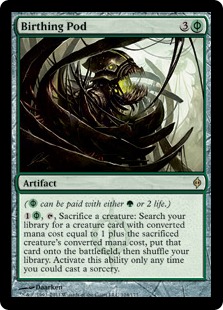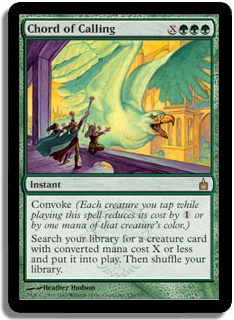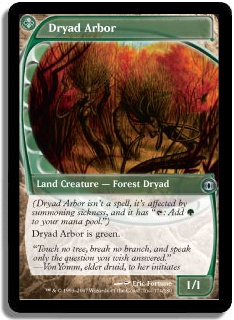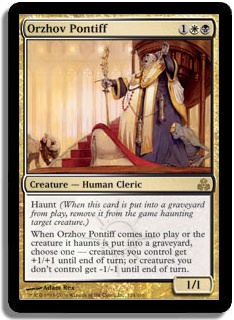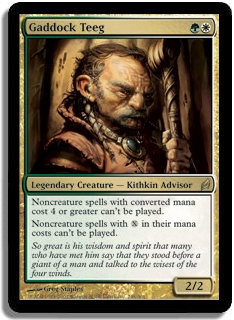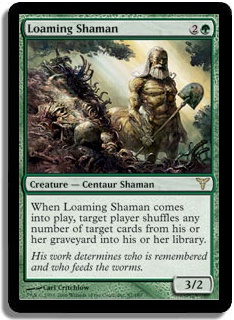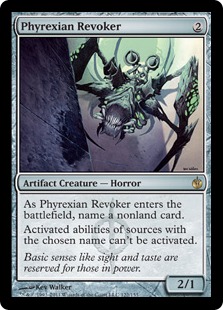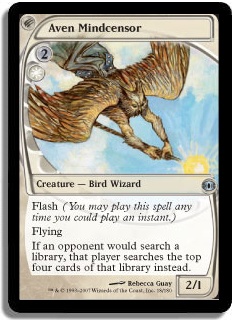Ahh, the written word. It has been a while since our last encounter, and it feels good to have my fingers working tirelessly again, pressing down on the keyboard. Sometimes you just need the little things in life to keep you stable and on track. There really aren’t a lot of things keeping me anchored to a schedule, so keeping something resembling a regimen is important, even if it is just sitting down to write 2-3,000 words a week. At the very least, it keeps my thought processes fresh. Practice keeps us as close to perfect as we’re going to get. Without practice, there really is no point to showing up for the big game. You’re going to lose.
I’ve been out of town for the last two weeks, returning last Tuesday on what would normally be my “writing day,” but driving for ten hours can take a lot of the will out of you. Modern has been through some tumultuous times since my last written article, and now we have to look at every strategy in a new light. Without Wild Nacatl or Punishing Fire on the radar, a lot of archetypes become viable again. Without the pressure to always play a Wild Nacatl aggro deck, regardless of what colors you want to play, people can really start brewing aggro decks that don’t begin with “1 Sacred Foundry, 4 Wild Nacatl.” Overall, I think the bannings will be a good thing for Modern, but I still think the format has a ways to go before it is “perfect.”
Earlier this week, some of you may have watched my videos on brewing a new deck for Modern. Unfortunately, a lot of my choices for cards were rather poor based on my self-instituted time constraints and resulted in a very bad deck that couldn’t beat a Kird Ape in a million years. I’m sure we could work on the deck to make it viable, though I’d rather just attack the format from a different angle. It is fairly clear that people want to play anything and everything in this new format, ranging from Smallpox to UrzaTron. Thus, we should build decks that are much better at fighting off “anything and everything” rather than trying to prey on one archetype. Degenerate combos are still an option, but most of those are very easy to see coming, and most people will have plenty of hate cards to disrupt you.
With that said, Jund is a great place to start but not really my favorite archetype in the world to pilot. Without Punishing Fire, I feel like it is going to take a lot more work to beat aggressive strategies, though that doesn’t necessarily make them bad matchups. While Lightning Bolt is a great start, it doesn’t always deal with opposing annoyances like Tarmogoyf, so adopting cards like Maelstrom Pulse and Terminate will probably be the next step. While I don’t think Jund is necessarily a bad deck, it isn’t really something I’d want to bring to the party in my first PTQ of the year. Jund is boring and almost always at the mercy of the opponent’s top of the deck. You can Thoughtseize and Blightning your opponent until they turn blue in the face, but most decks in Modern are packed full of powerful cards that just completely alter the face of the game state when they resolve.
Melira: A New Beginning
One deck that has been picking up a ton of steam, yet probably could be built a little better, is Melira Pod. Without Punishing Fire in the format to dismantle your combo pieces, Melira will surely get a chance to shine. For those of you who haven’t seen the deck:
Creatures (27)
- 4 Birds of Paradise
- 1 Eternal Witness
- 4 Wall of Roots
- 1 Harmonic Sliver
- 1 Shriekmaw
- 1 Reveillark
- 4 Kitchen Finks
- 1 Murderous Redcap
- 1 Ethersworn Canonist
- 1 Ranger of Eos
- 1 Tidehollow Sculler
- 3 Viscera Seer
- 1 Sun Titan
- 3 Melira, Sylvok Outcast
Lands (22)
Spells (11)

The two best cards in the deck, as you’ve probably guessed:
These two cards allow the deck to function like a Midrange Rock deck with an absurd tutor-package, backed by a strong combo finish. The easiest combo to pull off is infinite life via Kitchen Finks, Melira, and Viscera Seer, but Murderous Redcap can deal them infinite damage as well if you need to end the game on the spot. Since Kitchen Finks is a better creature on its own, and cheaper to cast, it is the combo you want to focus on assembling first. Since most decks can’t beat infinite life anyway, both combos are essentially the same thing.
Without Punishing Fire to keep this deck down, it is difficult for any fair deck to interact with it positively. Given enough time, this deck can just win the game on the spot. There are plenty of cases where you can just attack your opponent to death with Kitchen Finks, but your Chord of Calling and Birthing Pod all but ensure that you’ll be picking them off with the perfect creature at the perfect time or just killing them in response to the haymaker they’re tapping out for.
While each piece is an intricate part of the puzzle, there is plenty of room for innovation. Today we’re going to look at the current decklist, as well as a few spicier options we could use to innovate the archetype in the near future.
Normally, the deck plays out a few early mana producers in Birds of Paradise and Wall of Roots, occasionally backed up by some sort of disruption. Cards like Tidehollow Sculler are quite devastating when naturally drawn alongside an Inquisition of Kozilek or two and tend to slow the opponent down and limit their interaction with your combo. As you progress your board, your best line of play usually involves playing a Birthing Pod. Without Birthing Pod, your deck becomes much easier for other decks to play against, but you will usually still have the upper hand. With an instant-speed tutor, you can search up any creature that would ruin your opponent’s plan.
Against most aggressive decks, this is going to involve searching up Kitchen Finks or Murderous Redcap, both of which are excellent for assembling your combo as well as slowing down their clock. Kitchen Finks is particularly annoying since his large amount of power usually allows him to trade with an opposing creature for +4 life gain. If you already have a Melira in play, Kitchen Finks and Murderous Redcap become absolutely bonkers, even without the Viscera Seer on the table. After boarding, you will have a few more options, but each situation is unique and requires a different answer.
Against most combo decks, you’ll want to find whatever card best disrupts them at the time. Tidehollow Sculler can be annoying for many decks that are mid-combo, but Ethersworn Canonist absolutely shuts down Storm decks. Most of the Pyromancer Ascension decks that have been popping up lately have very few ways, if any, to kill an Ethersworn Canonist in the first game. If they have a spell on the stack, you can tutor for Ethersworn Canonist mid-combo to blank every spell they’ve cast that turn and keep them from playing any other spells that turn. Other combo decks will require other answers, but Tidehollow Sculler and Ethersworn Canonist are both good enough to warrant maindeck slots in the current metagame.
Other combo decks that aren’t storm-based are a little tougher to tutor against. When facing off against something like Splinter Twin, Shriekmaw can be bonkers but is very expensive. Since they can’t redirect Shriekmaw’s ability to Spellskite, you can catch them off guard so long as they don’t have a Dispel for your Chord of Calling. Your own Spellskite out of the sideboard can also ruin their day, since it can be searched for with Chord of Calling on the cheap, while Shriekmaw takes a bit more work. If an opponent’s combo isn’t trying to interact with you, then your best bet is to just side in Thoughtseize and try to assemble your combo faster than they do. If they are trying to interact with you, then your goal should be to minimize your interaction with them. While this can get confusing, just remember that you are a combo deck first and foremost.
Most control and midrange decks won’t really be able to compete with you without some specific hate card. Grim Lavamancer and Torpor Orb are probably going to be the only two things you’re even worried about, but Qasali Pridemage handles one while a variety of removal can handle the other. Path to Exile is the obvious removal of choice for opponents packing the little nuisance, but I wouldn’t recommend siding it in too much. After all, there is a reason it isn’t in your maindeck. Path to Exile is also very good against Splinter Twin, which shouldn’t be forgotten.
The Breakdown
Currently, the deck is filled with the following:
8 Tutor Effects
11 Combo Pieces
8 Mana Accelerators
8 Value Creatures
3 Disruption Spells
22 Lands
I’m sure these numbers could be adjusted slightly, but here is the baseline of the deck. There is a delicate balance between these areas in the deck and one that should not be forgotten when sideboarding. Cards like Obstinate Baloth are nice and all, but if you start taking out combo pieces to fit it into the deck, you’re going to have a harder time digging for your last Viscera Seer (or whatever you decided to cut).
I’m actually a huge fan of adding additional disruptive elements to the deck, since Inquisition of Kozilek and Thoughtseize are two of the best cards in the format. Inquisition is even solid against aggressive strategies, as it allows you to limit their interaction with your combo. If you can successfully resolve a Birthing Pod, it becomes incredibly difficult to lose the game to a deck that is attacking you.
Since Spellskite doubles as a preventative measure to opposing removal spells on top of its ability to dagger Splinter Twin, I’m a huge proponent of playing this card in the maindeck. The problem comes in finding the room, as most of the creatures in the deck fill niche rolls that few other creatures in the format can replicate. It is important never to forget that Birthing Pod needs the creature to be one-cost larger than the creature you are sacrificing, forcing you to create a delicate balance of costs in deckbuilding, something to keep in mind if you start changing the creature base.
With such a reliance on the “toolbox” aspect of the deck, you can occasionally lose sight of the bigger picture. There are a lot of situations where it is correct to Chord of Calling for very specific creatures, but other times you should just be focusing on your combo and endgame. Each decision becomes more and more difficult as your opponent applies more pressure, but a lot of the cards in your deck double as preventative measures while providing you with much-needed resources. It is actually hilarious how good Wall of Roots is in this deck, since five toughness is bigger than almost every (relevant) creature in Modern. Being able to sacrifice Wall of Roots to Birthing Pod to search up your Kitchen Finks is also pretty sweet, not to mention the ability to both convoke and add a mana to your pool for Chord of Calling.
The decision trees you find yourself on can be complicated, but a lot of them will come from practice and honing your own skills with the deck. Just tonight I sacrificed a Ranger of Eos in an attempt to search out a Shriekmaw, only to find that I had sideboarded it out (and already had a Reveillark in play). There are a lot of small interactions you might miss, but that is no reason to give up on the deck after a few losses. There aren’t a lot of ways in Modern to positively interact with the card Birthing Pod, so using this to your advantage early in the PTQ season will be a definite bonus.
Cards to Watch
There are a lot of cards I’m really looking forward to trying out in this deck, so please feel free to chime in with your own additions in the comment section (and short explanations why). Here are some of my personal favorites:
With Chord of Calling, you rarely want to get another mana producer, but this allows you to in a pinch. Additionally, you can fetch it up with a green fetchland and sacrifice it to Birthing Pod to find Viscera Seer for your combo. The deck has a few ways to get Viscera Seer already, but I feel like he is the most vulnerable piece of the combo and one you should be able to get repeatedly. Without Green Sun’s Zenith, I wouldn’t expect too many people to adopt this little guy, but he can also be a pretty sweet surprise blocker for a Dark Confidant!
I’ve already seen a few lists playing this guy, and I’ve felt his power first-hand. He’s also quite bananas with Viscera Seer, allowing you to easily trigger his haunt ability. With aggressive decks on the rise, I might expect this guy to make a slight splash. Chord of Calling being able to fetch him mid-combat can be particularly devastating to an unsuspecting opponent.
There aren’t a lot of combos relevant that this guy shuts off, and he hinders your ability to cast future Chords of Callings as well as future Birthing Pods. However, if the format begins to lean towards Ad Nauseam and Hive Mind, he could be a serious addition to the sideboard.
There aren’t too many graveyard-related decks in the current format, but this guy is just insane against any you might face. Brian DeCandio has been sporting a Hedron Crab–Vengevine deck as of late, and if something like that picks up in popularity, Loaming Shaman could be your saving grace.
While this guy isn’t exciting, there are a lot of cards in the format that require activated abilities. Any and all Aether Vial decks are considerably hindered by the presence of this little nuisance, and you could potentially lock down your opponent’s Deceiver Exarch/Pestermite with a Splinter Twin on it mid-combo. While Spellskite might be better, Spellskite can’t actually stop Kiki-Jiki with a Deceiver Exarch, since both abilities have the addendum “you control” on them.
This guy has been seeing a lot of play in Legacy over the past few months, and I wouldn’t bat an eye if he started to pick up steam in Modern! With so many search effects in almost every deck, he is a very strong consideration for the maindeck since he only affects your opponent. Using Chord of Calling to get this guy in response to an opposing Birthing Pod or Chord of Calling in the mirror is actually just laughable. With almost every deck in the format playing fetchlands, you can almost always get value out of him, even if you draw him naturally.
…
I think Melira is a very solid deck with few bad matchups and something you can really exploit in the early parts of the PTQ season. People don’t really know how to interact with Birthing Pod, and taking free wins from unsuspecting opponents is always a plus. The first time you Chord of Calling in a live PTQ, expect your opponent to read the card, frown, and allow it to resolve. Afterwards, kill them with a combo that they probably didn’t see coming.
The fact of the matter is that Melira is not a fast combo deck, but it is easily the most resilient, both to hate and opposing combo decks. Your toolbox allows you to fight them on any level you see fit and gives you more virtual copies of the cards that just send them packing. Finding the perfect mix of combo and control elements is the trick and something you can only really find through hours of testing and rigorous work. If you aren’t willing to put in the hours, maybe you should find a deck that is a bit easier to tune and test. As I said earlier, Jund is a great starting point.
As the format progresses from week to week, you can expect to see a considerable amount of change to the utility creature package in this deck. While the core of the deck is pretty solid, the important pieces surrounding the combo that help disrupt the opponent or dig you out of bad situations should vary depending on what you plan on facing off against or what you feel you are weakest against.
Over the next few weeks, I will be bringing you guys more video content on the Modern format and trying to provide you with the best material pertaining to relevant decks and archetypes. As the PTQ season gets underway this weekend, innovative and interesting decklists will begin pouring in, and I’ll be here to help you understand and perfect them as the format changes from week to week. I hope you enjoyed this return to the written word! Look for my next video article!
Thanks for reading.
Todd
strong sad on MODO

